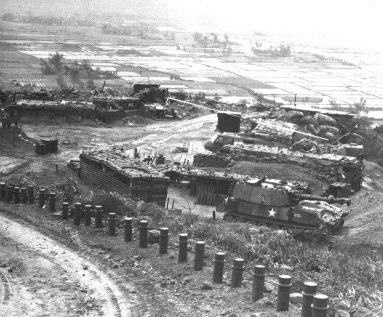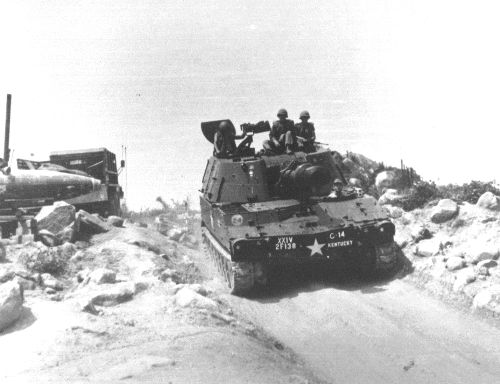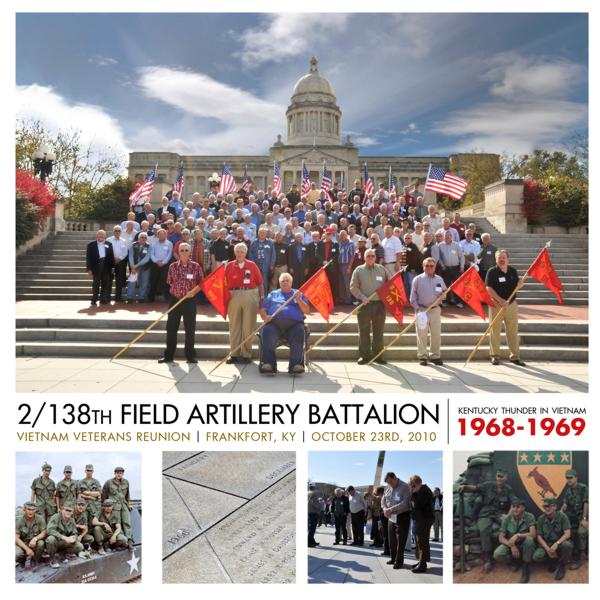1968 - 1969

C Battery, 2/138th at Firebase Denise, 1969
On April 19, 1968, the 2d Battalion, 138th Field Artillery with units in Louisville, Bardstown, Elizabethtown and Carrollton, Kentucky were ordered to active duty by President Lyndon B. Johnson. Among 24,500 men ordered to active duty in 88 units across the United States were 570 Kentucky Guardsmen and 750 Kentucky Air Guardsmen.
After approximately three weeks of processing, the Army Guardsmen were flown to Fort Hood, Texas, for concentrated field training and combat qualification. Following the heritage, which had been passed down through the generations of the Kentucky National Guard, these men performed their duties with the utmost of expertise. These were civilian soldiers taken from their civilian jobs to perform the task of liberating from Communist tyranny a tiny country practically on the other side of the world. Even though such was quite unpopular with many U.S. citizens, these centurions carried the torch of freedom for posterity. During the months before deployment to the Republic of Vietnam, 105 men sought an injunction from shipping the unit to a hostile zone without a declaration of war by the U.S. Congress. The U.S. Supreme Court refused to issue the injunction. These men had their day to be heard and never once complained of being sent to Southeast Asia. Not one man failed to do his duty commendably.
The Kentucky men showed much spirit. This was indicated by their disregard for a Department of Defense policy, which disallowed two brothers serving together in a combat zone. The 2d Battalion had numerous pairs of brothers serving in combat, as well as many who had brothers serving with the U.S. Regulars in South Vietnam. Such concern truly brought out the inbred motto of Kentuckians, "United We Stand, Divided We Fall."

Battery C, 2 / 138th Field Artillery in Vietnam - believed to be Mike Simpson's gun at Firebase Denise 1969.
The 2d Battalion of the 138th Field Artillery established headquarters at Gia Le Combat Base. Its firing batteries occupied such famous bases as Fire Base Bastogne, Tomahawk Hill, and Hamburger Hill. Its responsibility was to provide fire support for the Screaming Eagles of the 101st Airborne Division, whose home is Fort Campbell, Ky. Together they were to keep North Vietnamese regulars from destroying neighboring villages that were located along the China Sea. In this endeavor the Kentucky National Guard had provided such superior fire support that NVA sappers, demolition experts, were given the life-or-death mission of completely destroying Charlie Battery of Bardstown. Charlie Battery had created utter destruction for the NVA and the only possible hope was an attempt to destroy her. Later intelligence indicated that the NVA had practiced their mission of destruction because it was well aware of Charlie Battery's battle adeptness.
The evening of June 19, 1969, was a quiet one for Charlie Battery on Tomahawk Hill. There had been few attacks by the enemy in the previous days and fire missions were at a minimum. It was pouring rain. South Vietnamese rainstorms are much different from those in the States. It comes down with such force that one would think a dam had broken. The rain numbs all hearing senses and limits visibility to one foot. The infiltrators are pleased with such climate as it allows them movement, which normally would be checked. Many of the off-duty men of Charlie were watching a James Bond movie or thinking about their loved ones back in Kentucky.
Meanwhile, approximately 150 NVA sappers were amassing outside the perimeter of the compound. Twenty-two infantrymen from the 101st Airborne Division were manning the perimeter. At approximately 0145 about 75 of the sappers, clad only in loin cloths and skullcaps with satchel charges strapped to their bodies and carrying RPG's, shoulder-firing rocket launchers, proceeded to snake through the barbed concertina wire barricade. Supported by a mortar unit the NVA sappers completely overran the defending infantry, killing and wounding most of them.
A Bardstown man shouted the first alarm and the destruction was on. The deadly sappers, who were, as would be later confirmed, on drugs, moved around devilishly free with no fear of death. They threw satchel charges into the bunkers, killing and wounding many. The wounded as well as the unharmed fought back with every ounce of life to drive the madmen from the firebase. At the same time, other units of the Kentucky Guard at other firebases were shelled by the NVA so that they could provide little or no fire for Charlie Battery.
The sappers delivered approximately 150 satchel charges and RPG's. After destroying an ammunition storage area, three howitzers, nine bunkers, the mess hall, dining tent, maintenance building, four ammunition carriers, three 21/2-ton trucks, two 3/4-ton trucks, and three jeeps, the marauders of the night were forced to retreat. Cobra gunships zeroed in on the NVA position and forced the surviving NVA sappers to run for their lives.
The enemy felled nine Kentucky Guardsmen but he lost 23 on the battlefield. Other dead he carried off so as not to allow the Kentucky men the satisfaction of knowing they had bluntly checked the NVA's attempted goal: total destruction of Fire Base Tomahawk. The Kentuckians took one prisoner, from which they learned much so that no such attack could occur again.
Senior Commander in Vietnam, General Creighton Abrams, said the 2nd Battalion 138th Field Artillery, was "one of the best trained, and absolutely the best maintained battalion-sized unit in Vietnam."
Meanwhile, in Kentucky, on May 27, 1968, 700 Guardsmen were ordered to Louisville to quell a racial riot as state and local police fought late into the night to restore order after rioting and looting erupted in the city's West End. Six units from Louisville were originally called to curb the disturbance. Seventeen incidents of burning automobiles, looting of stores and vandalism had occurred before the Guard established its headquarters at Brandeis Elementary School. The mission of the Guardsmen was to protect firemen who were attempting to extinguish fires initiated by arsonists. There were a total of 29 incidents of looting, vandalism, and arson in the 90-minute period after the command post was set up.
The rioting centered around 28th and Greenwood. It was there that the action began at 8:30 p.m. following a rally protesting reinstatement of a Louisville policeman accused of using excessive force in arresting a African-American on May 8. The rioting fanned out for blocks as gangs of African-American youths roamed the streets. The price tag for the disturbance was pegged at $200,000. The cost of maintaining the Guard for the period was estimated from $30,000 to $40,000 per day.
In October of 1969 a welcome home ceremony was held for the Second Howitzer Battalion who had returned from Vietnam. Members of the Guard stood proudly in honoring its achievements. The spring of 1970 was a violent one. President Richard Nixon had committed troops into the fishhook of Cambodia in order to check North Vietnamese supply lines and rest camps, which had been used as springboards for campaigns against the allied forces. Back home in the U.S., the college campuses were humming with dissatisfaction as evidenced by the numerous campus disorders. The powder, which set the explosion, was the incident at Kent State University in Ohio. Four students had been accidentally struck and killed by bullets, which allegedly came from the muzzles of Ohio Guardsmen. This incident created chaos on many of the college campuses throughout the U.S. The University of Kentucky also had its problems. On the night of May 5, Governor Louie B. Nunn issued an emergency proclamation after witnessing the destruction of the Air Force Reserve Officers Training Corps (ROTC) Building. Two hundred eighty-five Guardsmen were called to aid in the protection of state property and human life. On May 7, 1000 student protesters were dispersed by tear gas for failure to break up an unlawful assembly. Such was a distasteful task for the Guard for many of the men were students at the University themselves. Yet they performed outstandingly in keeping peace on the campus without a major incident. After four days the Guardsmen had settled all chaos and had kept the University intact for the citizen taxpayers of the Commonwealth.
Approximately 125,000 Kentuckians served in the Vietnam War. One thousand seventy-seven gave their lives.
Kentucky Thunder in Vietnam
"KENTUCKY THUNDER IN VIETNAM: History of the 2nd Battalion, 138th Field Artillery in the Vietnam War 1968 - 1969" By John M. Trowbridge (2010) KENTUCKY THUNDER IN VIETNAM. The year 2009 marked the 40th Anniversary of the return to the Bluegrass from Vietnam following a 12-month tour of duty for the men of the 2nd Battalion, 138th Field Artillery, Kentucky Army National Guard.
"KENTUCKY THUNDER IN VIETNAM: History of the 2nd Battalion, 138th Field Artillery in the Vietnam War 1968 - 1969" By John M. Trowbridge (2010) KENTUCKY THUNDER IN VIETNAM

Additional Resources